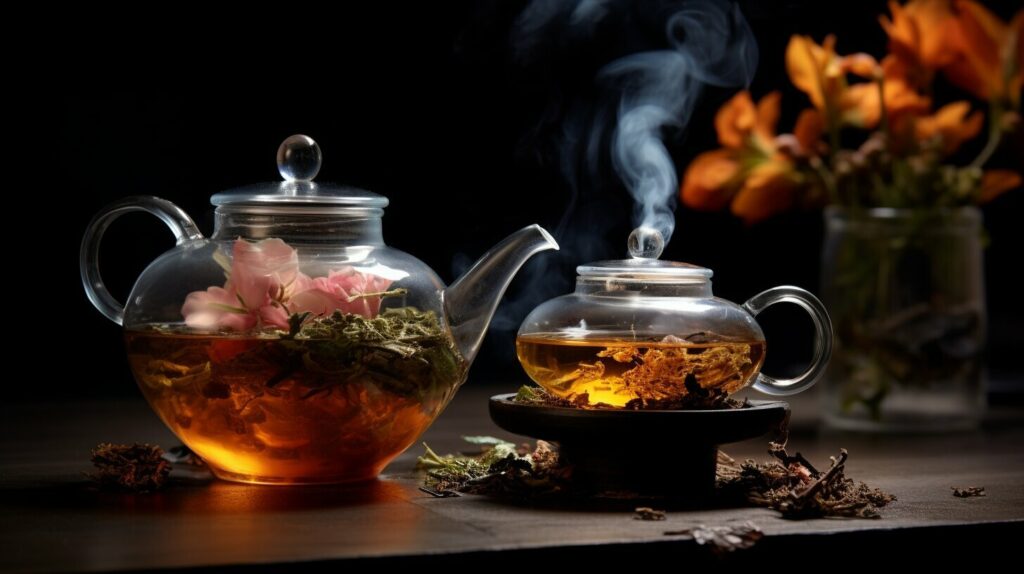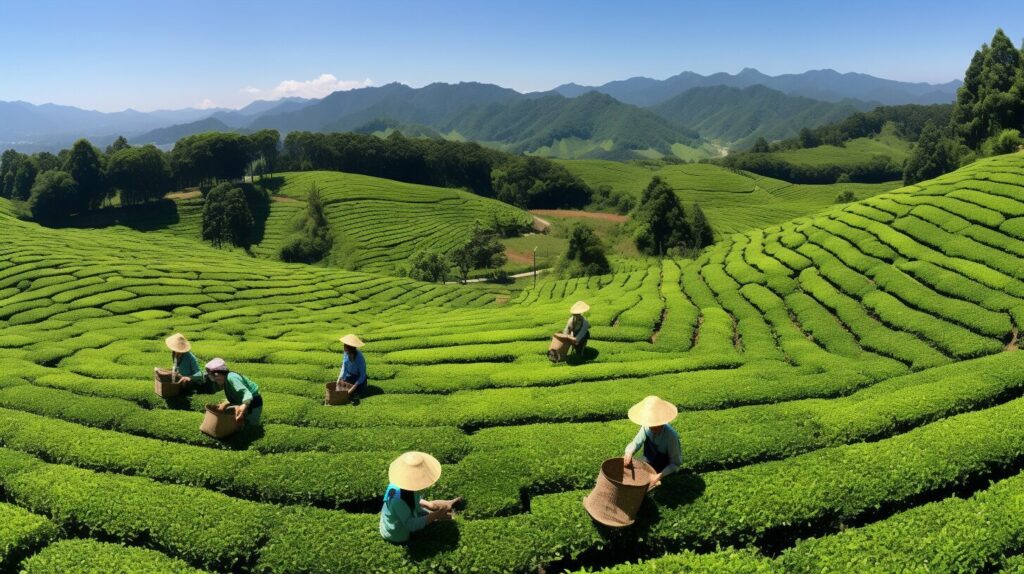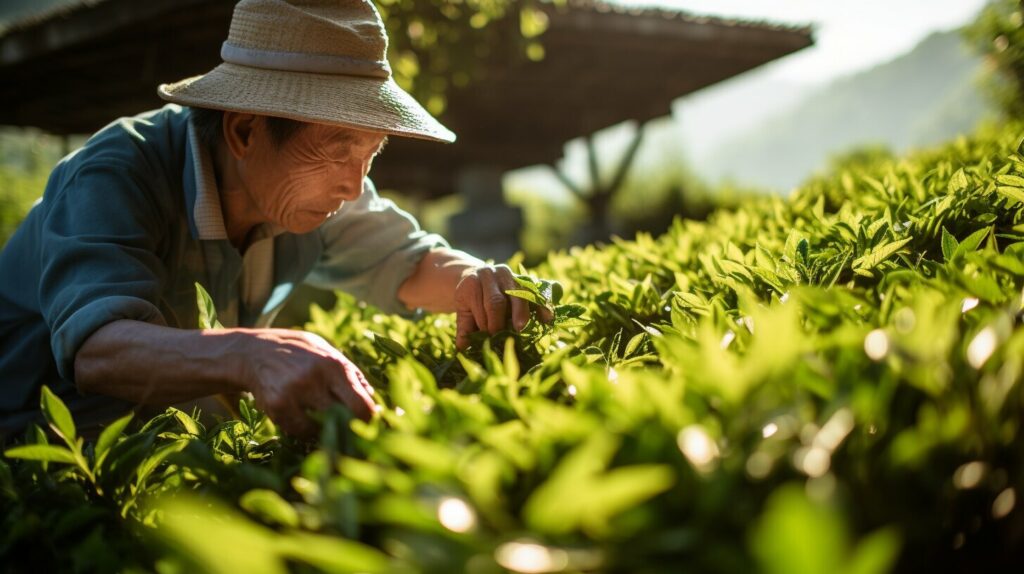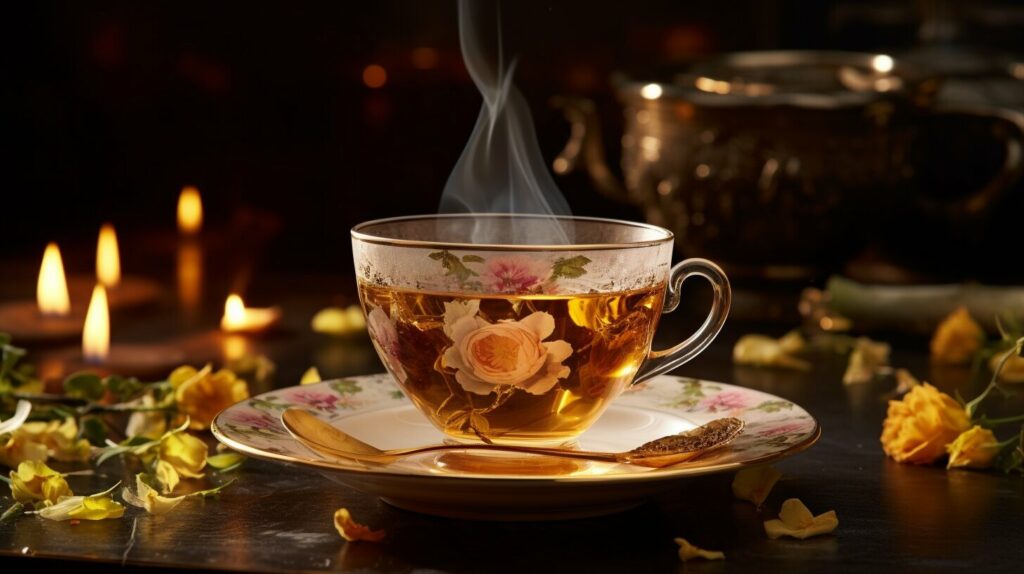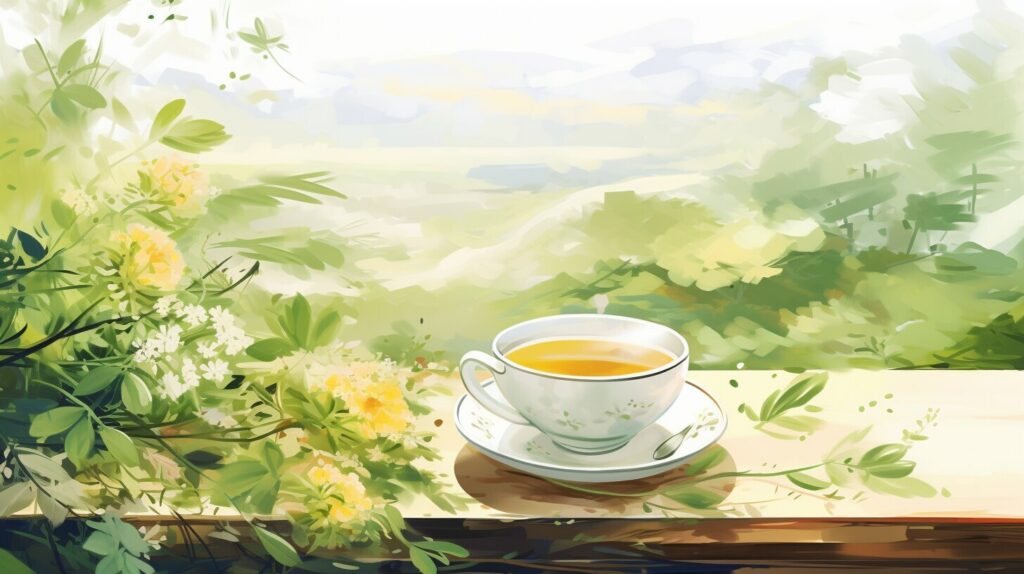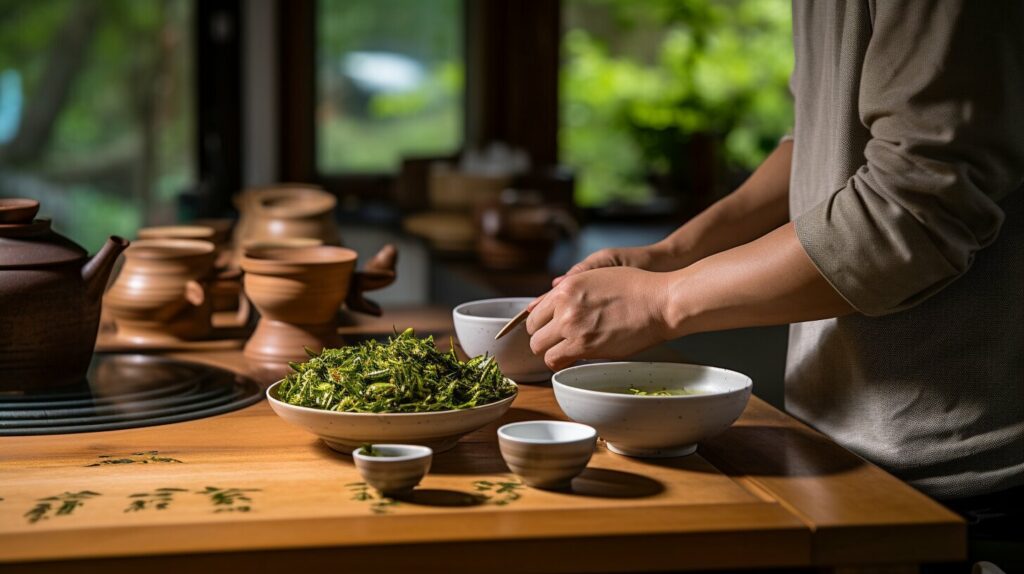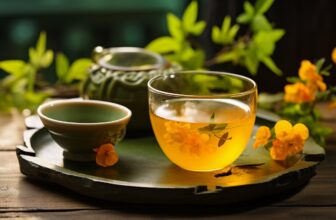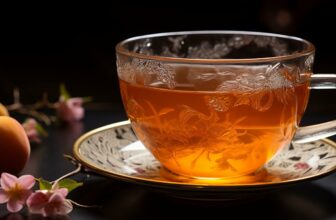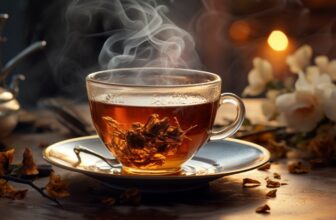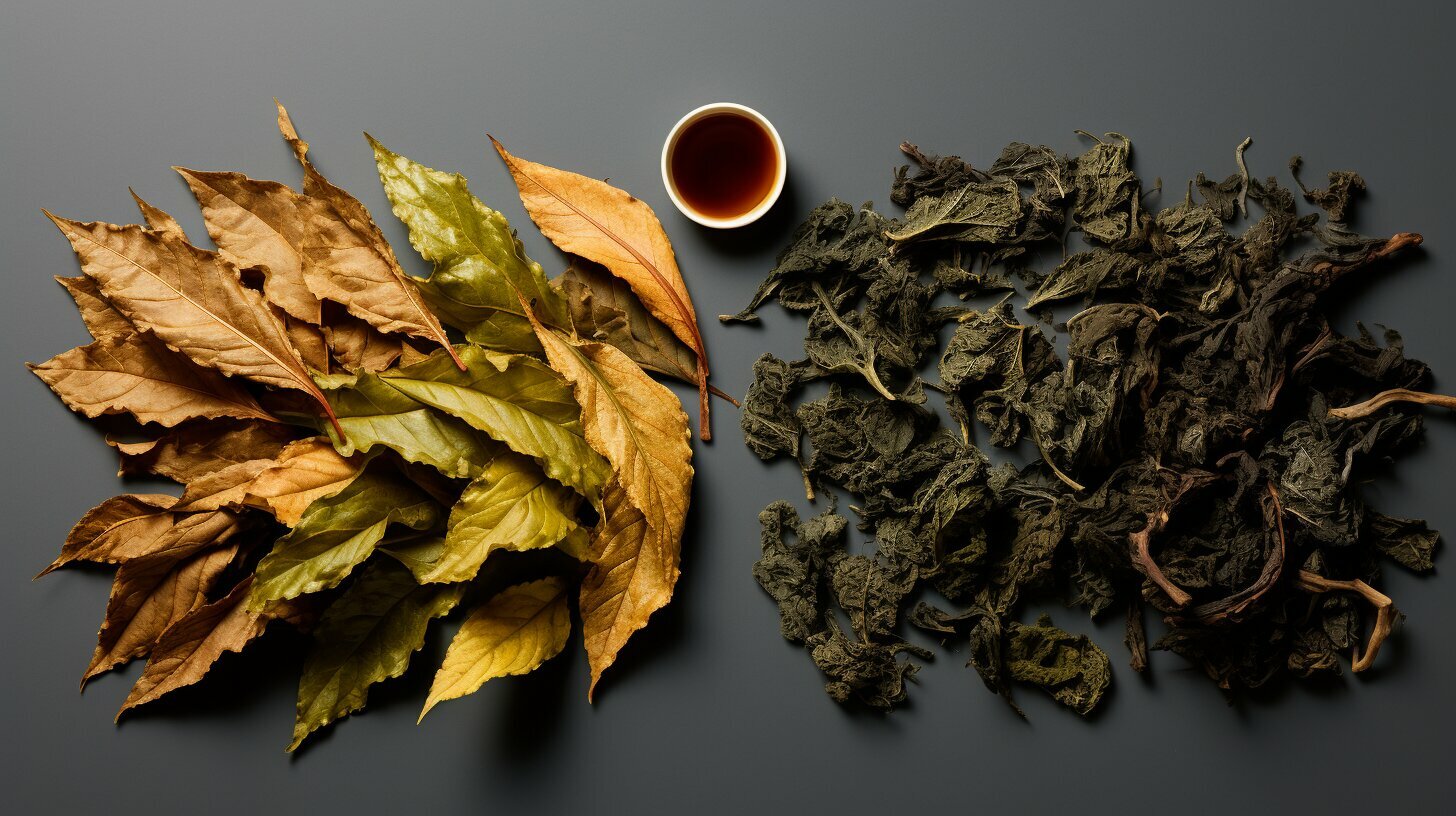
Oolong tea is a fascinating beverage that falls in between the realms of green and black tea. How exactly does it differ from its black tea counterpart? Let’s delve into the unique qualities of oolong tea and understand what sets it apart.
Oolong tea undergoes a distinctive production method and boasts a flavor profile that distinguishes it from other teas. Traditionally cultivated in China and Taiwan, oolong tea is now grown in various countries across the globe. It not only offers a delightful taste but also provides numerous health benefits, including improved digestion, weight loss, and increased metabolism.
The oxidation process plays a crucial role in defining the flavor profile of oolong tea. Unlike black tea, which is fully oxidized, or green tea, which is barely oxidized, oolong tea falls in between with oxidation levels ranging from 8% to 80%. This partial oxidation gives oolong tea its distinct flavor, varying from fresh and green to malty and black tea-like.
Oolong tea, made from the leaves of the Camellia sinensis plant, undergoes a meticulous production process involving withering, rolling, oxidation, roasting, and drying. The degree of oxidation determines the flavor and color of the tea, with most popular varieties having a moderate oxidation level of 20-60%.
With its diverse flavors and aromas, oolong tea offers a unique tasting experience. These flavors can range from floral and fruity to sweet and toasty, making it comparable to fine wines. The color of the tea leaves and the brewed tea can also vary, from green to golden to brown.
So, if you’re an avid tea drinker looking to explore something new and exciting, oolong tea is a must-try. Its intriguing production process, diverse flavor profiles, and health benefits make it a captivating and delightful beverage.
Key Takeaways:
- Oolong tea falls between green and black tea in terms of oxidation.
- It has a unique production method and flavor profile.
- Oolong tea is traditionally made in China and Taiwan but is now produced in other countries as well.
- The oxidation process determines the flavor profile of oolong tea, with less oxidized varieties having a fresher taste.
- Oolong tea offers a wide range of flavors, from floral and fruity to toasty and malty.
The Oxidation Process and Flavor Profiles
The oxidation process plays a crucial role in determining the flavor profile of oolong tea. Unlike black tea, which is fully oxidized, and green tea, which is barely oxidized, oolong tea falls somewhere in between with oxidation levels ranging from 8% to 80%. This unique level of oxidation results in a diverse range of flavors and aromas.
Less oxidized oolongs tend to have a fresher and greener taste, similar to that of green tea. They exhibit lighter and more delicate flavors with floral and fruity notes. On the other hand, highly oxidized oolongs lean towards a stronger, maltier flavor, reminiscent of black tea. These oolongs often have a deeper, richer color and a more robust taste. The shape of the tea leaves also contributes to the flavor profile, as oolong teas are traditionally rolled, twisted, or curled.
“The oxidation process in oolong tea gives it a unique and complex flavor profile.”
| Oxidation Level | Flavor Profile |
|---|---|
| Light (8% – 30%) | Refreshing, floral, and fruity |
| Moderate (30% – 60%) | Balanced, smooth, and semi-sweet |
| High (60% – 80%) | Malty, bold, and robust |
The oxidation process in oolong tea brings out the nuances and complexity of its flavor, allowing tea connoisseurs to explore a wide spectrum of tastes. From delicate and floral to bold and malty, oolong tea offers a sensory experience like no other.
Origins and Cultivation of Oolong Tea
Oolong tea, with its unique flavor and characteristics, has its origins in China and Taiwan. These two countries have a long history of producing and perfecting this exquisite tea. Chinese oolong teas are traditionally grown in high mountainous regions with cool weather and rocky terrains, which contribute to the rich flavor and unique qualities of the tea. Taiwan’s oolongs, on the other hand, have a greener color and lighter flavor compared to their Chinese counterparts.
While China and Taiwan are known for their traditional oolong teas, this captivating beverage is now cultivated in other parts of the world as well. Oolong tea production has expanded to countries like India, Sri Lanka, Japan, Thailand, and even New Zealand. Each region has its own cultivation methods and environmental conditions, resulting in oolong teas with distinct flavors and aromas.
The cultivation of oolong tea is an art in itself. Farmers carefully tend to the tea plants, ensuring they receive the right amount of sunlight, shade, and nutrients. In some areas, oolong tea is grown in terraced gardens, allowing for optimal drainage and access to fresh mountain air. These meticulous cultivation practices, combined with the unique geographical conditions of each region, contribute to the diverse range of oolong tea varieties available today.
The Variety of Oolong Tea
Oolong tea is available in a wide range of varieties, each with its own distinct characteristics. Here are some popular oolong tea varieties:
| Variety | Origin | Flavor Profile |
|---|---|---|
| Tie Guan Yin | China | Floral and creamy |
| Dong Ding | Taiwan | Roasted and full-bodied |
| Formosa Oolong | Taiwan | Light and fruity |
| Wuyi Rock oolong | China | Mineral and earthy |
These are just a few examples of the diverse oolong tea varieties available. Each variety offers a unique flavor and aroma, allowing tea connoisseurs to explore and appreciate the nuances of oolong tea.
As oolong tea continues to gain popularity around the world, it is fascinating to see how its cultivation has spread and adapted to different environments. This has resulted in a rich tapestry of flavors and styles, making oolong tea a truly remarkable beverage.
The Production Process of Oolong Tea
Producing oolong tea is a meticulous process that involves several steps to achieve its unique flavor and characteristics. Understanding the production process helps appreciate the craftsmanship and complexity behind this beloved tea.
Step 1: Withering – Fresh tea leaves are spread out and left to wither, allowing moisture to evaporate. This step makes the leaves more pliable and prepares them for rolling.
Step 2: Rolling – The withered leaves are carefully rolled, breaking their cell walls and releasing enzymes and essential oils. Rolling also helps shape the tea leaves into their characteristic forms, such as tight balls or thin strands.
Step 3: Oxidation – After rolling, the leaves undergo oxidation, either naturally through exposure to air or artificially using machines. The oxidation process determines the flavor and color of the oolong tea. Less oxidized oolongs have a fresher and greener taste, while highly oxidized varieties develop a darker, more robust flavor.
Step 4: Roasting – To halt the oxidation process and enhance the flavor, the leaves are roasted. The degree of roasting varies depending on the desired taste profile. Roasting can add depth and complexity to the tea, imparting toasty or smoky notes.
Step 5: Drying – Finally, the leaves are dried to remove any remaining moisture and lock in the flavors. The dried tea leaves are sorted and packaged, ready to be brewed and enjoyed.
Through this intricate production process, oolong tea acquires its distinct flavor profile, balancing the freshness of green tea with the rich depth of black tea. The craftsmanship involved in each step contributes to the complexity and allure of this revered tea.
Table: Oolong Tea Production Steps
| Step | Description |
|---|---|
| Withering | Fresh tea leaves are spread out and left to wither, reducing moisture content. |
| Rolling | The withered leaves are rolled, breaking their cell walls and releasing enzymes and essential oils. |
| Oxidation | The leaves are oxidized, either naturally or artificially, to develop desired flavor and color. |
| Roasting | The oxidized leaves are roasted to enhance flavor and add complexity. |
| Drying | The leaves are dried to remove moisture, sorted, and packaged. |
Flavor and Aroma of Oolong Tea
Oolong tea is renowned for its wide range of flavors and delightful aromas. The unique characteristics of oolong tea result from its partial oxidation process, which creates a diverse and intricate flavor profile. From floral and fruity notes to malty and black tea-like undertones, oolong tea offers a rich and satisfying taste experience.
“The flavor profile of oolong tea is often compared to that of fine wines, as different processing techniques and growing conditions can result in unique and complex flavors.”
The oxidation level of oolong tea directly affects its flavor and aroma. Less oxidized oolongs tend to have a fresher and greener taste, with vibrant floral and grassy notes. On the other hand, highly oxidized oolongs develop a darker hue and offer a more robust and malty flavor, reminiscent of black tea.
Exploring the Spectrum of Oolong Tea Flavors
Tea aficionados can indulge in a wide array of oolong tea flavors that cater to diverse palates. Some oolong teas exhibit a light and delicate character, with subtle fruity undertones and a refreshing finish. Others boast a full-bodied and robust profile, with deep caramel and roasted notes that leave a lingering warmth.
- Green oolong teas: These lightly oxidized teas are known for their fresh and grassy flavors, often resembling green tea. They offer a crisp and clean taste, with hints of floral and vegetal notes.
- Tie Guan Yin oolong: This highly esteemed oolong tea variety from China entices with its floral fragrance and complex taste. It showcases a harmonious blend of orchid-like aromas, buttery smoothness, and a sweet, lingering aftertaste.
- Dark oolong teas: With their deeper oxidation, these teas develop a robust flavor profile, similar to black tea. They exhibit rich caramel and toasted grain notes, offering a bold and satisfying brew.
Each cup of oolong tea is a journey of discovery, revealing nuances and subtleties that tantalize the taste buds. The intricate flavors and captivating aroma make oolong tea a true delight for tea enthusiasts seeking an exceptional and memorable tea-drinking experience.
| Tea Type | Flavor Profile | Aroma |
|---|---|---|
| Green Oolong Tea | Crisp and fresh with floral and vegetal notes | Grassy and delicate |
| Tie Guan Yin Oolong | Buttery smooth with orchid-like flavors and a sweet aftertaste | Floral and fragrant |
| Dark Oolong Tea | Bold and robust with caramel and toasted grain notes | Rich and inviting |
Health Benefits of Oolong Tea
Oolong tea offers a range of health benefits that make it a popular choice among tea enthusiasts. With its unique combination of antioxidants, oolong tea promotes overall well-being and supports a healthy lifestyle. Let’s explore some of the key health benefits of oolong tea:
- Weight Loss: Oolong tea is known for its potential to aid in weight loss. It contains polyphenols that help boost metabolism and increase fat oxidation, assisting in the breakdown of stored fat. Regular consumption of oolong tea, combined with a balanced diet and exercise, can contribute to weight management goals.
- Antioxidant Properties: Rich in antioxidants, oolong tea helps protect the body against free radicals. These harmful substances can cause cellular damage and lead to various health issues. Antioxidants in oolong tea neutralize free radicals, reducing their negative impact and promoting cellular health.
- Gut Health: The polyphenols found in oolong tea have been linked to improved digestion. They can help stimulate the production of digestive enzymes, aiding in the breakdown and absorption of nutrients. Oolong tea may also have prebiotic effects, promoting the growth of beneficial gut bacteria.
- Heart Health: Regular consumption of oolong tea has been associated with lower cholesterol levels and improved heart health. The antioxidants in oolong tea help reduce the oxidation of LDL cholesterol, which can contribute to the development of cardiovascular diseases. Oolong tea may also help lower blood pressure, reducing the risk of heart-related issues.
- Stress Relief: Oolong tea contains theanine, an amino acid known for its relaxing effects. Theanine promotes a sense of calm and relaxation, reducing stress and anxiety. Enjoying a cup of oolong tea can provide a soothing experience and help in maintaining a balanced mental state.
These are just a few of the many health benefits that oolong tea offers. Incorporating oolong tea into your daily routine can provide a flavorful and enjoyable way to support your overall well-being.
| Health Benefit | Description |
|---|---|
| Weight Loss | Aids in boosting metabolism and increasing fat oxidation, assisting in weight management goals. |
| Antioxidant Properties | Rich in antioxidants that neutralize free radicals, promoting cellular health and reducing oxidative stress. |
| Gut Health | Stimulates the production of digestive enzymes and promotes the growth of beneficial gut bacteria. |
| Heart Health | Helps lower cholesterol levels, reduce blood pressure, and protect against cardiovascular diseases. |
| Stress Relief | Contains theanine, which promotes relaxation, reduces stress, and promotes a balanced mental state. |
Brewing Tips for Oolong Tea
When it comes to brewing oolong tea, attention to detail is key in order to achieve the perfect cup. Here are some helpful tips to ensure you make the most of this unique and flavorful tea:
- Start with fresh water: To bring out the best flavors in oolong tea, it is important to use fresh water that is free from any off-flavors. Avoid using water that has been previously boiled or has a strong taste.
- Use the right amount of tea: For optimal taste, it is recommended to use approximately 2 grams of loose-leaf oolong tea per cup. Adjust the amount accordingly if you prefer a stronger or milder brew.
- Consider the steeping time: The steeping time for oolong tea typically ranges from 3 to 5 minutes. However, the exact time can vary depending on personal preferences. Experimentation is key to finding the perfect balance of flavors.
- Strain and enjoy: Once the steeping time is complete, it is important to strain the tea to remove the leaves. This ensures a smooth and enjoyable drinking experience. Oolong tea can be enjoyed hot or cold, depending on your preference.
Remember, brewing oolong tea is a personal experience, and it may take some experimentation to find the perfect brewing method that suits your taste. Don’t be afraid to try different steeping times, water temperatures, and amounts of tea to discover your preferred flavor profile. Sit back, relax, and savor the unique taste and aroma of oolong tea.
Customer Testimonial:
“I have always been a fan of oolong tea, and learning how to brew it properly has elevated my tea-drinking experience. By following the recommended steeping time and using fresh water, I now enjoy a delightful cup of oolong tea with its complex flavors and delicate aroma. It has become a relaxing and rejuvenating part of my daily routine.” – Sarah, Oolong Tea Enthusiast
So go ahead, grab your favorite oolong tea leaves, and embark on a journey of flavors. With the right brewing techniques, you’ll be able to unlock the true potential of oolong tea and enjoy its unique taste to the fullest.
| Brewing Tip | Description |
|---|---|
| Start with fresh water | To bring out the best flavors in oolong tea, it is important to use fresh water that is free from any off-flavors. Avoid using water that has been previously boiled or has a strong taste. |
| Use the right amount of tea | For optimal taste, it is recommended to use approximately 2 grams of loose-leaf oolong tea per cup. Adjust the amount accordingly if you prefer a stronger or milder brew. |
| Consider the steeping time | The steeping time for oolong tea typically ranges from 3 to 5 minutes. However, the exact time can vary depending on personal preferences. Experimentation is key to finding the perfect balance of flavors. |
| Strain and enjoy | Once the steeping time is complete, it is important to strain the tea to remove the leaves. This ensures a smooth and enjoyable drinking experience. Oolong tea can be enjoyed hot or cold, depending on your preference. |
Conclusion
In conclusion, oolong tea offers a unique and enticing experience for tea enthusiasts. Its distinctive characteristics, resulting from the partial oxidation process, make it stand out from both black and green teas. The diverse range of flavors and aromas, from floral and fruity to malty and black tea-like, provides a wide array of options to explore.
The meticulous production process of oolong tea, including withering, rolling, oxidizing, roasting, and drying, ensures the tea leaves are transformed into a flavorful and aromatic beverage. Oolong tea’s cultivation and processing methods vary, leading to different types and flavors, adding to the richness and versatility of this tea.
Furthermore, oolong tea brings along numerous health benefits, such as aiding in weight loss, boosting metabolism, and improving heart health. Its calming effect also promotes relaxation and overall well-being. Whether enjoyed hot or cold, oolong tea provides a delightful and refreshing experience.
For those seeking a tea with a unique profile and a touch of elegance, oolong tea is the perfect choice. Its complexity, combined with its health benefits, makes it a beverage worth exploring and savoring. Discover the world of oolong tea and let its flavors and aromas transport you to a realm of tea enjoyment like no other.
FAQ
What is oolong tea?
Oolong tea is a type of tea that falls between green and black tea in terms of oxidation. It is traditionally made in China and Taiwan but is now produced in other countries as well.
How is oolong tea different from black tea?
Oolong tea undergoes a partial oxidation process, while black tea is fully oxidized. This results in different flavors and color profiles between the two types of tea.
What flavors can I expect from oolong tea?
Oolong tea can have a range of flavors, including floral, fruity, sweet, or toasty. The oxidation level and processing techniques contribute to these variations.
Where is oolong tea grown?
Oolong tea is traditionally grown in China and Taiwan, but it is now cultivated in other countries such as India, Sri Lanka, Japan, Thailand, and New Zealand.
What are the health benefits of oolong tea?
Oolong tea offers various health benefits, including improved digestion, weight loss, increased metabolism, and heart health. It also contains antioxidants that protect the body against free radicals.
How do I brew oolong tea?
To brew oolong tea, start with fresh water and use around 2 grams of loose-leaf tea per cup. Steep for approximately 3 minutes, adjust according to personal preference, and strain before enjoying hot or cold.
